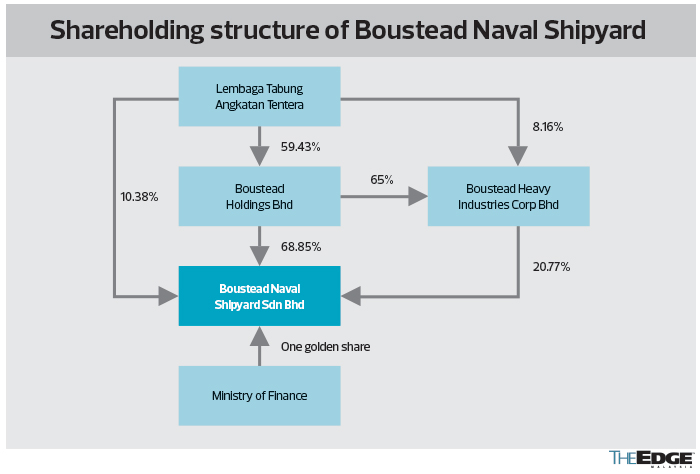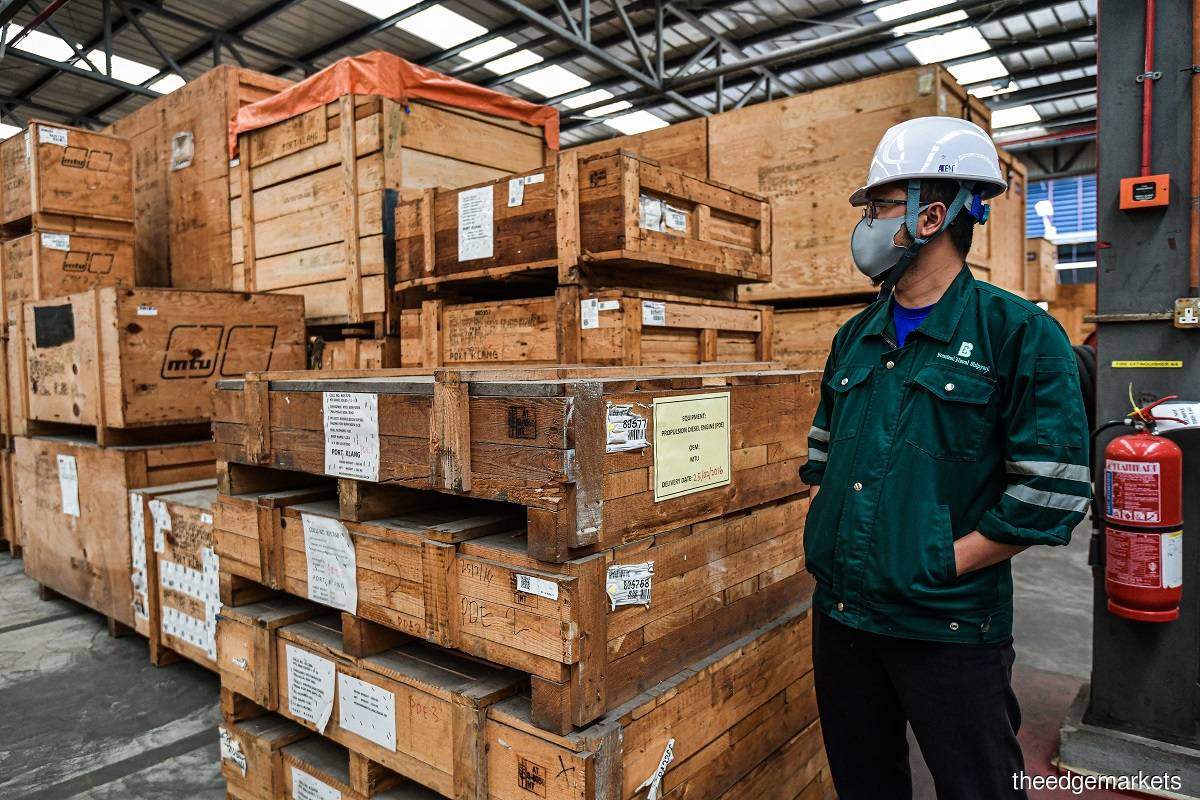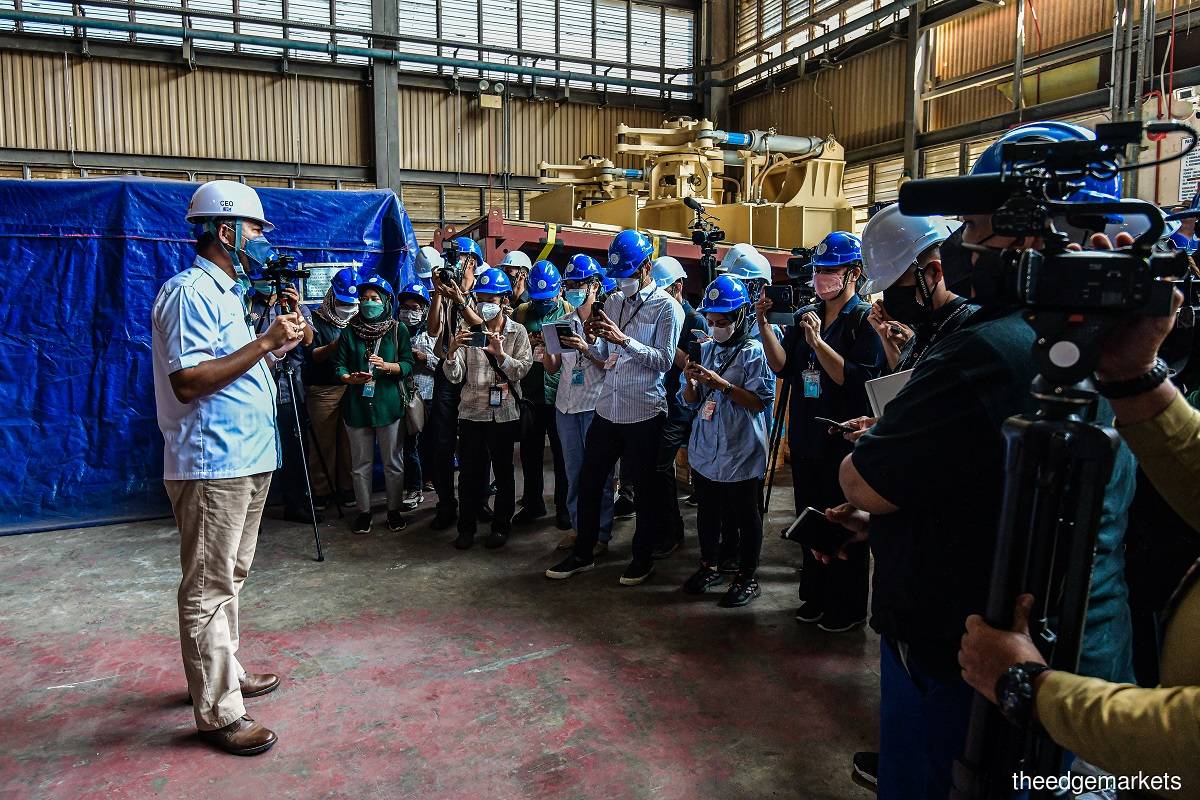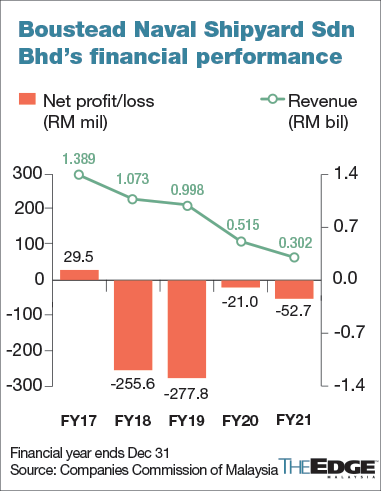Visit to LCS Site Hints at a Long Sail Towards Completion
edgeinvest
Publish date: Tue, 16 Aug 2022, 08:36 AM
KUALA LUMPUR (Aug 15): The Ministry of Defence (Mindef) on Saturday (Aug 13) invited the media to visit the Boustead Naval Shipyard Sdn Bhd (BNS) facility in Lumut, Perak, where littoral combat ships (LCS) are being built — slightly more than a week after the release of the Public Accounts Committee (PAC) report on the findings of the probe into the RM9 billion LCS project.
The project was awarded to BNS, a unit of Boustead Holdings Bhd which is controlled by the Armed Forces Fund Board or LTAT, in 2013.
According to the initial completion deadline, the company should have shown journalists five completed LCS. Sadly, the visit — a rare occasion in a navy base — was instead to show the media the bulk order of the equipment that it bought for RM3.5 billion, and the structure of the first LCS that BNS has constructed.
The navy, the single largest client of BNS, expected the delivery of the first LCS in April 2019. But BNS failed to deliver it.
The contention surrounding the LCS project is that RM6.1 billion has been disbursed by the Government for the LCS project, but not one single vessel has been completed by BNS. The Malaysian Anti-Corruption Commission is investigating the case now.
The project's progress has been affected by things like design changes, stop-work pending investigations, cash flow issues, and the Covid-19 pandemic, among others, said BNS chief executive officer Captain Azhar Jumaat.
The company’s shipyard, sitting on land leased from the federal government, is located within the Royal Malaysian Navy military base in the port town of Lumut, three hours from Kuala Lumpur.
The small town is not as lively as expected, despite the megaproject being said to have several hundred vendors and a few thousand workers.
Not a worker was spotted working at the shipyard, except for a handful of BNS employees who helped facilitate the tour. However, the host pointed out that the yard is usually packed with people on weekdays, particularly welders working on the ships’ bodies.
How is the project doing?
Journalists were guided to two warehouses, where the equipment worth a combined RM1.7 billion are kept.
The wooden boxes stacked in the warehouse didn't appear to have gathered a thick layer of dust. The scene was like the military warehouse in the fourth Indiana Jones movie, but smaller in size. Most of them are labelled with the delivery dates, such as 2017 and 2019. The media were not able to see the contents, nor would they know the actual values.
“Money has been spent on buying this equipment…it was not lost entirely. We need to pre-order this equipment, as this is not something that we could buy off the shelf,” said Azhar, who was tasked with briefing the media.
LTAT CEO Datuk Ahmad Nazim was also present at the shipyard, but he didn’t speak to the press.
According to the PAC report, the equipment is said to be obsolete. Azhar refuted this, instead saying that the equipment was “facing obsolescence”, not obsolete. He stressed multiple times that there is a difference between being obsolete and obsolescence.
The equipment were fit for 30 years upon order, with a use-of-life of 25 years remaining, Azhar said. The original equipment manufacturers are reviewing the equipment, after which periodic intervention will be conducted to keep them in good shape.
Additionally, the electronic parts ordered, representing 30% of the value of the yet-to-be-installed equipment, are stored in the 24/7 air-conditioned warehouse, the media was told.
“All this really drives up the cost of maintenance and storage,” said Azhar after the rounds in the warehouses. “The longer we decide on how to move forward with the project, the more costs are going to be incurred.”
Later, journalists were brought to a tour inside the LCS1 — currently still largely a metal skeleton with the engines and gearbox installed. The ship is 60% completed.
Electronic equipment has yet to be installed in LCS1, because the ventilation systems have not been installed. The equipment would be damaged from heat without ventilation; LCS1 is partly exposed to the seaside sun.
The technical parts of the construction, including equipment installation, are still on hold pending further confirmation from the Government on the status of the project moving forward, Azhar said.
Further, a remainder of 5% of the entire LCS design works is still pending, amid issues of payment from BNS to its counterparties. At one point, there were up to 140 engineers working on the project, Azhar said.
The tour later moved to a workshop where military-grade metals are welded block by block before being attached together. “In a way, it is really like building Lego,” said the CEO, alluding to a recent internet meme by a local satirical graphic artist.
More money needed
Minus the RM1.7 billion of warehoused equipment and RM1.8 billion big-ticket equipment installed on some vessels, Azhar said the remaining RM2.5 billion was spent on “overhead, project management, financing costs, insurance, electricity, infra[structure], [and] construction”.
“It is not spent on things not related to the project,” he reiterated.
BNS also spent RM200 million for the upgrading of the shipyard to undertake the job, but the amount was not included in the initial project cost, said Azhar.
In total, five ships are under construction, said Azhar. The last unit has yet to be built, and the saving grace is that the equipment has yet to be ordered as well — otherwise, that will further add to BNS’ cash-burn.
What does this mean?
Having spent RM6.08 billion, BNS will still need fresh funds to: i) service the existing equipment for the first five ships; ii) procure components and equipment for the sixth ship; iii) complete construction of all six ships, which stood at 57% completion at end-2020.
PAC proceedings found that the remaining RM3.05 billion may not be enough for BSN to complete its job — estimates in the PAC report suggested the amount will allow BNS to complete just two ships. Cost overruns totalled RM1.4 billion to date for numerous reasons, including equipment, design changes, and stop-work by subcontractors. The commission also cited double claims, and governance issues of variation orders, among others.
Azhar, however, declined to touch on how much funds the company will need to deliver all six vessels.
Based on recommendation by Mindef, as reported in the PAC report, LCS1 planned for delivery to the navy in 2025, followed by LCS2 and LCS3 by 2026, and the last one in 2028. This means that BNS will have taken 15 years to complete its job, provided no new major problems arise.
Company checks showed that BNS had current liabilities (debts that were due within six months) of RM2.05 billion as at end-2021, and long-term liabilities of RM167.3 million. Its current assets stood at RM1.22 billion, while non-current assets were at RM298.5 million.
The company’s retained losses swelled to RM828.34 million, after two years of losses exceeding RM250 million in the financial year ended Dec 31, 2018 (FY18) and FY19.
For FY21, BNS incurred a net loss of RM52.71 million against a revenue of RM302.15 million — a far cry from the performance in FY17, when it booked a net profit of RM29.46 million on a revenue of RM1.39 billion.
Despite the delays and prevailing challenges, throughout the tour Azhar reiterated that the company has the capability and technical know-how to get the job done, “as proven” by BNS in the past and considering the work progress to date.
“[BNS] is capable. We have five ships on the production line,” he said. “We have nothing to hide…we just want to focus on finishing the ships.”
The journey seems long and bumpier ahead for the six combat ships before their voyage in the South China Sea or Malacca Straits by 2028.
All said, showing the LCS project progress is not enough to quell public outcry — rightly so, as the massive project, likely costing more than RM10 billion, is fully-funded by taxpayers' money. The only way for BNS to prove its competence is to deliver to Malaysians all six ships needed to defend the nation.
Source: TheEdge - 16 Aug 2022
More articles on CEO Morning Brief
Created by edgeinvest | Apr 16, 2024
Created by edgeinvest | Apr 16, 2024
Created by edgeinvest | Apr 16, 2024












.png)






